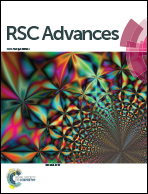Polymer–paclitaxel conjugates based on disulfide linkers for controlled drug release
Abstract
A novel redox-responsive polymer–drug conjugate (PDC) based on hydrophilic diblock copolymer covalently linked paclitaxel (PTX) via a disulfide linker was prepared and evaluated for intracellular drug delivery. The well-defined hydrophilic diblock copolymer, PEG-b-PHEMA, was synthesized via atom transfer radical polymerization of 2-(trimethylsilyloxyl)ethyl methacrylate (HEMA-TMS), using PEG-Br as a macroinitiator and CuBr/PMDETA as the catalytic system, followed by selectively hydrolyzing the trimethylsilane group to hydroxyl groups. Utilizing the hydroxyl groups as an active reaction site, paclitaxel was covalently conjugated onto the backbone of the diblock copolymer, with a disulfide linker as a spacer to bridge the copolymer and PTX, and the loading content of paclitaxel was 18.4 wt%. Due to the different solubility of segments in the polymer–drug conjugate, the amphiphilic PEG-b-P(HEMA-PTX) could self-assemble into spherical micelles in aqueous solution, with hydrophobic PTX as core and hydrophilic PEG chains as shell. The in vitro cytotoxicity experimental results showed that the diblock copolymer was biocompatible, with no obvious cytotoxicity, whereas the PEG-b-P(HEMA-PTX) conjugate showed glutathione-dependent cytotoxicity with higher cellular proliferation inhibition against glutathione monoester pretreated HeLa cells than that of the nonpretreated HeLa cells. We are convinced that polymer–drug conjugates based on disulfide linkers will be a promising platform for targeted intracellular controlled drug delivery in cancer therapy.


 Please wait while we load your content...
Please wait while we load your content...